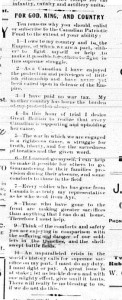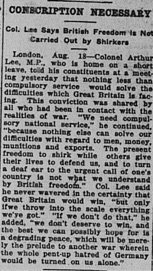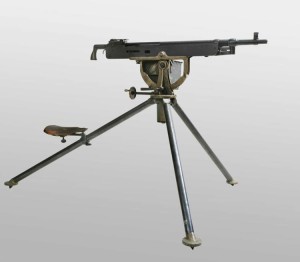There was far more enlistment from immigrants from the British Isles than from those born in Canada. An article like this one from The Ayr News demonstrated why Canadians ought to contribute all they can whether they enlist or give to the Canadian Patriotic Fund.
The article listed the ten reasons why Canadians should contribute. These reasons were mostly related to Canada honouring its duty to the Empire that was protecting it and to encouraging those still at home to do all they can to help those who have already gone to the front.
Readers were meant to feel guilty because they were enjoying the comforts made possible by their fellow countrymen and the mother country.
Conscription Necessary (18 August 1915)
In 1915, Canadians were still enlisting voluntarily at a high enough rate to maintain their units overseas, so conscription was not yet a serious topic of discussion. However, Canadians still took note when the United Kingdom began to debate the issue, as reported in this article reprinted from a London newspaper. The issue was particularly concerning in a region like Waterloo where enlistment rates had been lower than national averages because of its large German population. As in the UK, young men in Canada who would not enlist were demeaningly referred to as “slackers” and sometimes harassed when in public. For the time being, however, enlistment was high enough throughout Canada that nobody would need to be legally forced into the service.
Berlin Daily Telegraph August 18, 1915.
English, Kitchener, 109.
Machine Gun Donations (19 August 1915)
It was reported in July 1915 that Germany had 100 000 machine guns in the trenches on both fronts. It was also reported that Germany was producing machine guns at incredible rates, although there were differing estimates as to the actual number. Within one article, the rate of production switched from 500 guns per day to 500 per week. British Prime Minister David Lloyd George called for contributions of more machine guns and shells to even the field and to save the lives of Canadian men.
In August, it was reported that private donors across Canada had already raised enough to supply 1500 of these “portable death machines.” The town of Waterloo, and especially the Waterloo Board of Trade, responded by committing to their own machine gun donations. Waterloo had been criticized for low enlistment rates. Because it was believed that one machine gun was worth 80 soldiers, the board thought that contributing machine guns could redeem Waterloo. Waterloo Town Council agreed to contribute two guns which would be paid through temporary taxes over the next few years. The Board of Trade was expected to pay for three additional guns through private donations.
(“Machine Gun Warfare,” Berlin Daily Telegraph, 6 July 1915.; “Too Many Machine Guns Cannot Be Donated to the Canadians,” Waterloo Chronicle, 19 August 1915.; “What Canada Must Do,” Berlin Daily Telegraph, 28 July 1915.; “1,500 Machine Guns Provided Privately,” Waterloo Chronicle, 12 August, 1915.; “Waterloo Town Council Decides to Contribute Two Machine Guns,” Waterloo Chronicle, 19 August 1915.
Visual: Photo courtesy of the Canadian War Museum, http://www.warmuseum.ca/firstworldwar/wp-content/mcme-uploads/2014/07/19930003-125.jpg)
Waterloo Accused of Having Zero Recruits (19 August 1915)
Following both the sinking of the Lusitania and the call for expansion of the Canadian Army, Waterloo County, with its large German population, felt pressured to prove its loyalty. In May, an article in the Berlin Daily Telegraph had boasted that Berlin and Waterloo had together recruited nearly 150 soldiers for active service, and had formed a regiment with over 225.
Nonetheless, there were many inspiring recruitment stories from elsewhere. Reports from Toronto informed readers of their high recruitment numbers, that a man from Stratford tried to enlist eleven times, that many single men in Hamilton were being fired from their jobs to make them enlist; and that by August, 2000 Americans had joined the Canadian ranks.
On August 19, the Waterloo Chronicle published an example of the pressure Waterloo faced when a Chesley, Ontario newspaper falsely accused Waterloo of not yet having a single recruit.
(Norm Threinen, “Canadian Lutherans and the First World War,” Canadian Churches and the First World War, edited by Gordon L. Heath (Eugene, OR: Pickwick Publications, 2014): 203.; “Western Ontario Cities Have Contributed Many of their Sons to Fight Battles of Empire,” Berlin Daily Telegraph, 22 May 1915.; “K. of C. Urge Men to Enlist,” Waterloo Chronicle, 27 May 1915.; “Stratford Man Tries 11 Times to Join Troops,” Waterloo Chronicle, 15 July 1915.; “Weeding out the Single Men,” Waterloo Chronicle, 22 July 1915.; “2,000 Yankees in Canadian Ranks,” Waterloo Chronicle, 19 August 1915.; “Loyalty and Sense of Duty of Waterloo Young Men Seriously Impugned by Chesley Newspaper,” Waterloo Chronicle, 12 August 1915.)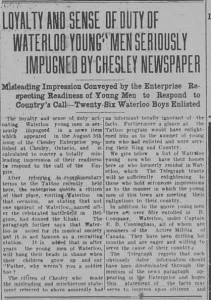
Galt Recruiting for the 34th Battalion (22 August 1915)
Another round of recruitment for the 34th Battalion occurred in Galt throughout August. A recruiting rally was held on August 22 at Scott’s Opera House in Galt. The house was filled to capacity and hundreds were reportedly turned away at the door. The rally was preceded by a parade of the 29th Regiment Brass Pipe and Bugle band and cars containing the children of fighting soldiers.
At a patriotic meeting in Milton on August 25, it was remarked that Canadians were now realizing that this was their war and those born in Canada were enlisting in increasing amounts. This sentiment was echoed in both the local town of Galt and the small community of Ayr. In Galt, the percentage of Canadian-born men who enlisted in the 34th Battalion in August was about a quarter of the total compared to just one tenth in the past January.
Galt took pride in its recruiting contributions which were comparable per capita to those of big cities including Toronto.
(“Big Recruiting Meeting Sunday,” Berlin Daily Telegraph, 20 April 1915.; “Big Patriotic Rally in Galt,” Berlin Daily Telegraph, 23 August 1915.; “Canadian-Born Realize Canada Is Now at War,” Berlin Daily Telegraph, 27 August 1915.; “Two more Ayr young men…,” Ayr News, 12 August 1915.; https://archive.org/details/CEF_34thBattalion_1915.; “Galt Sets Fine Example by Its Recruiting Pace,” Berlin Daily Telegraph, 31 August 1915.
Visual: http://regimentalrogue.com/battlehonours/infimages/034bn.jpg)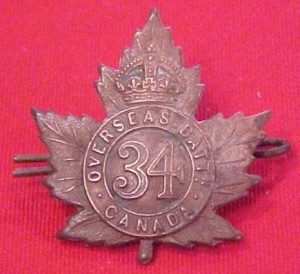
Large Donation of Peaches made to the Canadian Red Cross Society (26 August 1915)
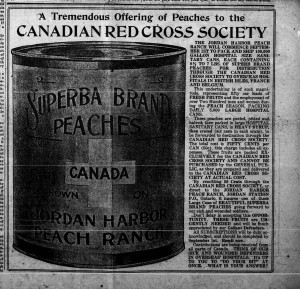 Advertisements using the war came in many forms and Jordan Harbor Peach Ranch advertised in a very patriotic way. The company stated that starting in September, they would be shipping 100,000 gallons of hospital sized cans of peaches, each containing six and a half to seven pounds of peaches, to hospitals in the British Isles, France and Belgium, distributed through the Red Cross Society. The advertisement also stated the cost for one of these large cans to be sent was 50 cents and both their company and the Canadian Red Cross Society would be accepting donations, allowing these cans to be sent overseas to feed wounded soldiers.
Advertisements using the war came in many forms and Jordan Harbor Peach Ranch advertised in a very patriotic way. The company stated that starting in September, they would be shipping 100,000 gallons of hospital sized cans of peaches, each containing six and a half to seven pounds of peaches, to hospitals in the British Isles, France and Belgium, distributed through the Red Cross Society. The advertisement also stated the cost for one of these large cans to be sent was 50 cents and both their company and the Canadian Red Cross Society would be accepting donations, allowing these cans to be sent overseas to feed wounded soldiers.
“A Tremendous Offering of Peaches to the Canadian Red Cross Society,” Ayr News, August 26, 1915.
